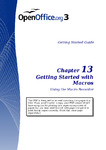Please use this identifier to cite or link to this item:
http://lib.hpu.edu.vn/handle/123456789/21017Full metadata record
| DC Field | Value | Language |
|---|---|---|
| dc.contributor.author | Pitonyak, Andrew | - |
| dc.contributor.author | Weber, Jean Hollis | - |
| dc.contributor.author | Pitonyak, Andrew | en_US |
| dc.contributor.author | Weber, Jean Hollis | en_US |
| dc.date.accessioned | 2016-06-08T02:34:59Z | |
| dc.date.available | 2016-06-08T02:34:59Z | |
| dc.date.issued | 2010 | en_US |
| dc.identifier.other | HPU3160121 | en_US |
| dc.identifier.uri | https://lib.hpu.edu.vn/handle/123456789/21017 | - |
| dc.description.abstract | A macro is a saved sequence of commands or keystrokes that are stored for later use. An example of a simple macro is one that “types” your address. The OpenOffice.org macro language is very flexible, allowing automation of both simple and complex tasks. Macros are especially useful to repeat a task the same way over and over again. | en_US |
| dc.format.extent | 28p. | - |
| dc.format.mimetype | application/pdf | - |
| dc.language.iso | en | en_US |
| dc.publisher | OOOAuthor | en_US |
| dc.subject | OpenOffice | en_US |
| dc.subject | Computer | en_US |
| dc.subject | Software | en_US |
| dc.subject | Macro Recorder | en_US |
| dc.title | Getting Started Guide Chapter 13 Getting Started with Macros Using the Macro Recorder | en_US |
| dc.type | Book | en_US |
| dc.size | 563Kb | en_US |
| dc.department | ICT | en_US |
| Appears in Collections: | ICT | |
Files in This Item:
| File | Description | Size | Format | |
|---|---|---|---|---|
| 16_Getting_Started_Guide_Chapter_13.pdf | 562.93 kB | Adobe PDF |  View/Open |
Items in DSpace are protected by copyright, with all rights reserved, unless otherwise indicated.
